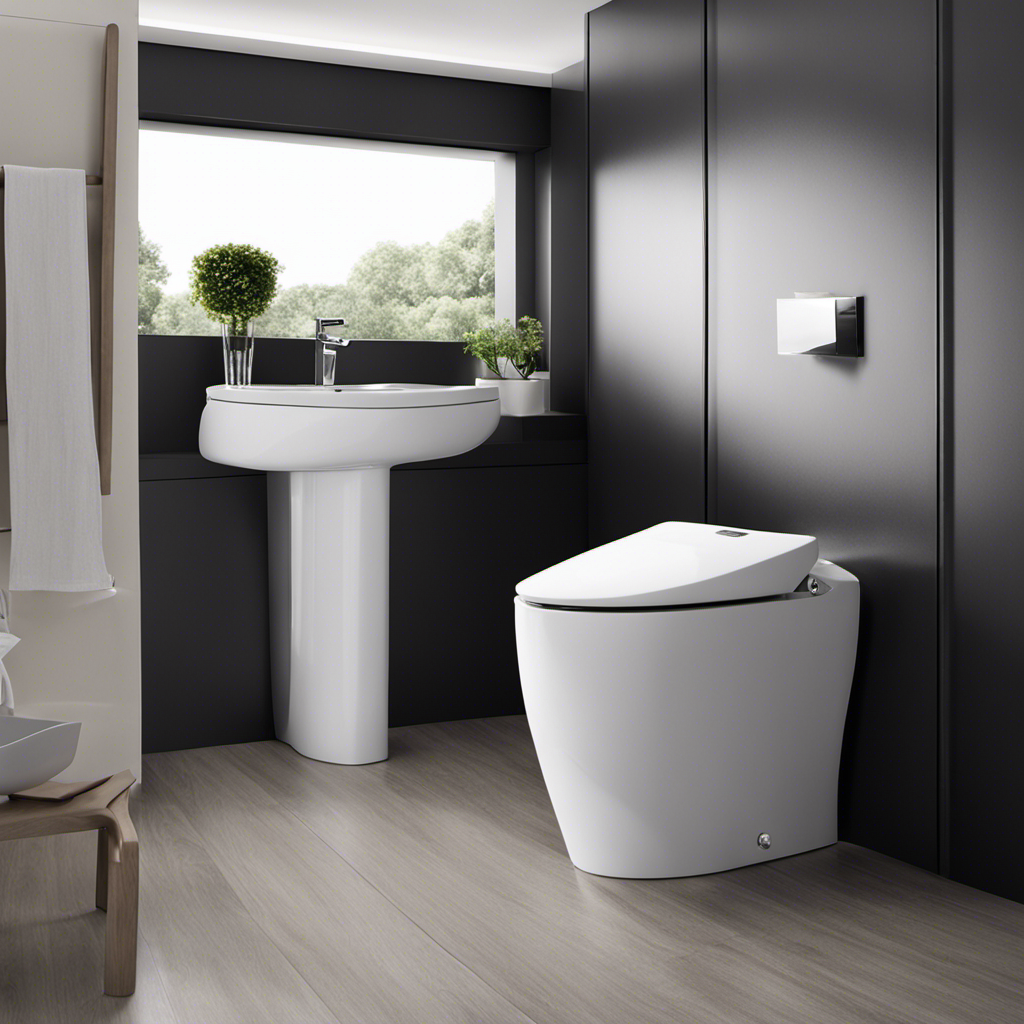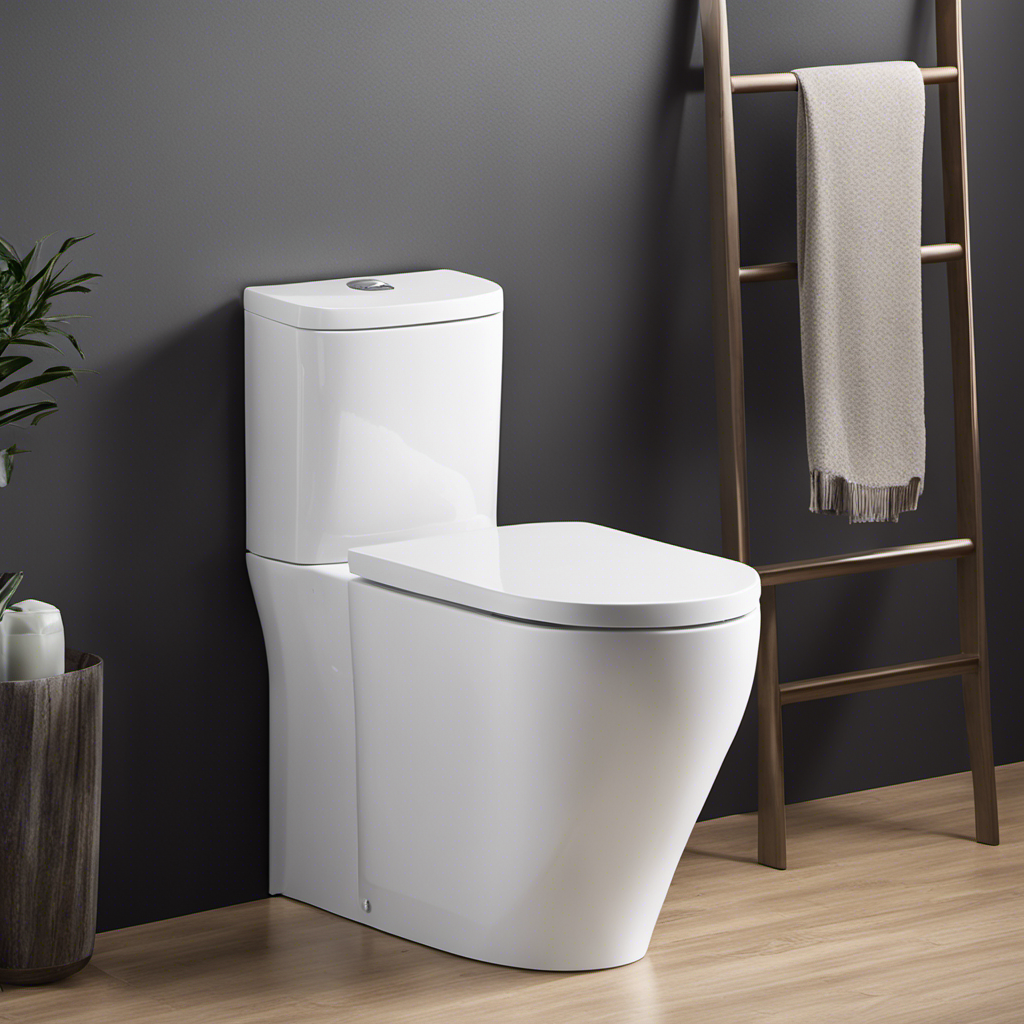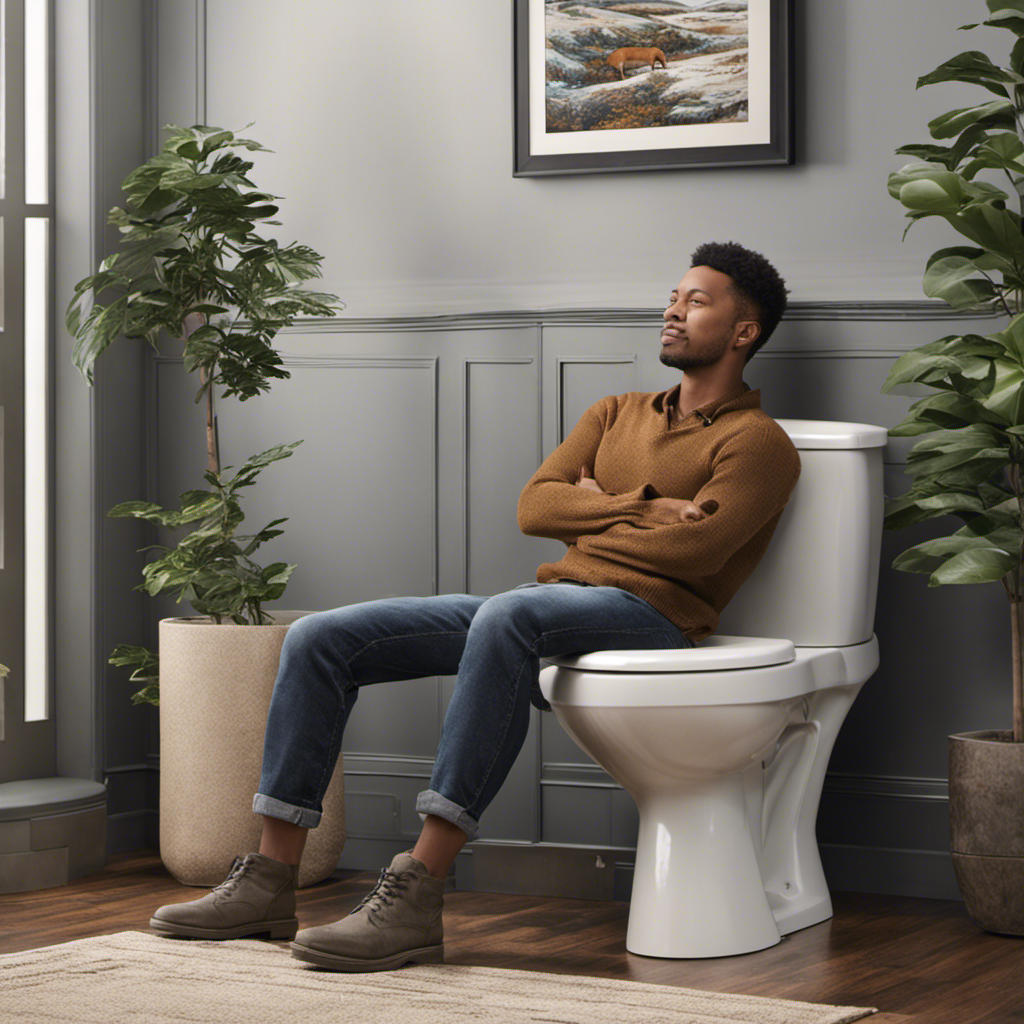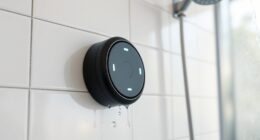Did you know that dual flush toilets can save up to 68% more water compared to traditional toilets? If you’re looking for an eco-friendly and cost-effective option for your bathroom, then a dual flush toilet might be the perfect choice for you.
In this article, we will explore the benefits, working mechanism, water-saving features, and maintenance tips for dual flush toilets. Additionally, we will help you navigate the installation process and guide you in choosing the right dual flush toilet for your home.
Key Takeaways
- Dual flush toilets save up to 68% more water compared to traditional toilets.
- They offer flexibility and control over water consumption.
- Dual flush toilets contribute to reducing water consumption and conserving water resources.
- They can lead to potential cost savings on water bills.
Benefits of Dual Flush Toilets
One of the benefits of dual flush toilets is that they allow you to choose between a higher or lower volume of water for flushing. This feature helps in reducing water usage, making dual flush toilets more environmentally friendly compared to traditional toilets. According to water usage comparisons, dual flush toilets can save up to 50% more water per flush than conventional toilets.
The ability to select a lower volume of water for liquid waste and a higher volume for solid waste allows for efficient water usage. Additionally, user satisfaction levels with dual flush toilets are generally high. Users appreciate the flexibility and control over water consumption, as well as the potential cost savings on water bills.
Overall, dual flush toilets offer a practical and eco-friendly solution for efficient water management in households.
How Dual Flush Toilets Work
Dual flush toilets employ a water-saving mechanism that allows users to choose between a low-flush and a high-flush option, depending on the waste being disposed of. The low-flush option uses significantly less water than traditional toilets, making it an effective tool for conserving water resources.
In addition to the water-saving benefits, dual flush toilets also contribute to reducing the environmental impact by minimizing the amount of water wasted and the energy required for water treatment processes.
Water-Saving Mechanism Explanation
To save water, you can use a dual flush toilet with its water-saving mechanism. Dual flush toilets are a great example of water conservation in toilet technology.
The water-saving mechanism of a dual flush toilet consists of two buttons or handles on the flush tank. The smaller button is for liquid waste, which uses less water, while the larger button is for solid waste, which uses more water. This allows you to choose the appropriate flush for the type of waste, reducing water usage significantly.
The dual flush toilet’s water-saving mechanism ensures that you only use the necessary amount of water, minimizing waste and promoting sustainable water usage. This technology not only helps you save water, but it also has a positive environmental impact by reducing water consumption and conserving this valuable resource.
Environmental Impact Reduction Benefits
You can make a significant impact on the environment by reducing water consumption and conserving this valuable resource. One way to achieve this is by investing in eco-friendly plumbing, such as a dual flush toilet. These toilets have become increasingly popular due to their ability to save water. Unlike traditional toilets that use a fixed amount of water for each flush, dual flush toilets offer two options: a full flush for solid waste and a half flush for liquid waste. This innovative design allows users to choose the appropriate amount of water needed, significantly reducing toilet water consumption. On average, a dual flush toilet can save up to 25,000 gallons of water per year compared to conventional toilets. By incorporating eco-friendly plumbing fixtures like dual flush toilets, you can contribute to water conservation efforts and help protect the environment.
| Pros | Cons |
|---|---|
| Significant water savings | Initial cost may be higher |
| Environmentally friendly | Requires proper maintenance |
| Customizable water usage | Limited design options |
| Potential cost savings |
Water Saving Features of Dual Flush Toilets
The water-saving features of dual flush toilets can greatly reduce water consumption. Here are three key features that make dual flush toilets efficient:
-
Two flush options: Dual flush toilets offer two flushing options – a partial flush for liquid waste and a full flush for solid waste. This allows you to choose the appropriate amount of water needed for each type of waste, resulting in significant water savings.
-
Low flow mechanism: Dual flush toilets are equipped with a low flow mechanism that limits the amount of water released per flush. This ensures that only the necessary amount of water is used, reducing water wastage.
-
Water-saving design: Dual flush toilets are designed with efficiency in mind. The bowl and trapway are shaped to facilitate effective waste removal with minimal water usage. Additionally, some models incorporate advanced technology, such as dual siphon jets, to maximize flushing power while conserving water.
By incorporating these water-saving features, dual flush toilets contribute to water conservation efforts.
Now, let’s compare dual flush toilets with traditional toilets.
Comparing Dual Flush Toilets With Traditional Toilets
When it comes to comparing dual flush toilets with traditional toilets, there are several key factors to consider.
First, dual flush toilets offer significant water-saving benefits, as they provide two flush options for different waste volumes.
Second, a flush effectiveness comparison reveals that dual flush toilets can be just as effective, if not more so, than traditional toilets in removing waste.
Lastly, it’s important to consider the cost and installation differences between the two types of toilets, as dual flush toilets may require a slightly higher upfront investment but can lead to long-term savings on water bills.
Water-Saving Benefits
Using a dual flush toilet can help conserve water by allowing you to choose between a full flush or a half flush. Here are three water-saving benefits of using a dual flush toilet:
-
Reduced water consumption: Dual flush toilets use significantly less water compared to traditional toilets. By selecting the half flush option for liquid waste, you can conserve water and reduce your overall water consumption.
-
Environmental impact: Opting for a dual flush toilet contributes to water conservation efforts and promotes eco-friendly options. By using less water, you are helping to preserve this valuable resource and minimize your environmental footprint.
-
Cost savings: Using a dual flush toilet can result in cost savings on your water bill. With the ability to choose a half flush for most waste, you can significantly lower your water usage and potentially save money over time.
By understanding these water-saving benefits, you can make an informed decision about using a dual flush toilet and its impact on water conservation and eco-friendly practices.
Now, let’s explore the effectiveness of dual flush toilets in comparison to traditional toilets.
Flush Effectiveness Comparison
Opting for a dual flush toilet can be more effective in conserving water compared to traditional toilets. Dual flush toilets offer different flush options for liquid waste and solid waste, allowing you to choose the appropriate amount of water needed for each flush. This flush efficiency is one of the key reasons why dual flush toilets are considered superior in terms of water conservation.
The liquid waste flush typically uses a smaller amount of water, while the solid waste flush uses a larger amount. By providing these options, dual flush toilets help reduce unnecessary water usage, leading to substantial water savings over time. This makes them a great choice for environmentally conscious individuals who are looking to minimize their water consumption.
Now, let’s explore the cost and installation differences between dual flush toilets and traditional toilets.
Cost and Installation Differences
To save money and simplify the installation process, you can choose a traditional toilet instead of a dual flush option. Traditional toilets are typically less expensive than dual flush toilets and require less complexity during installation.
Here are three key differences to consider when comparing the cost and installation of traditional toilets versus dual flush toilets:
-
Installation Costs: Traditional toilets are generally easier and quicker to install compared to dual flush toilets. This means that the labor costs associated with installing a traditional toilet will usually be lower.
-
Water Consumption: Dual flush toilets are designed to offer two flushing options – a full flush for solid waste and a reduced flush for liquid waste. This feature helps to conserve water by using less for liquid waste. In contrast, traditional toilets typically use a fixed amount of water per flush, which may result in higher water consumption over time.
-
Maintenance: Traditional toilets tend to have fewer moving parts and simpler mechanisms, making them easier to maintain and repair. Dual flush toilets, on the other hand, may require more frequent maintenance and repair due to their more complex flushing system.
When considering the cost and installation differences between traditional toilets and dual flush toilets, it is important to weigh the upfront cost savings against potential long-term water consumption and maintenance costs.
Installation Process for Dual Flush Toilets
The installation process for dual flush toilets is straightforward and can be completed in just a few steps. To help you understand the process better, here is a table outlining the steps involved:
| Step | Description |
|---|---|
| 1 | Shut off the water supply to the existing toilet. |
| 2 | Remove the old toilet and clean the area. |
| 3 | Install the new dual flush toilet according to the manufacturer’s instructions. |
| 4 | Connect the water supply line to the toilet. |
| 5 | Turn on the water supply and check for any leaks. |
Maintenance Tips for Dual Flush Toilets
Regular maintenance is essential for ensuring the efficient performance of your dual flush toilets. To keep your toilets in top shape, follow these maintenance tips:
-
Clean the toilet regularly: Use a mild detergent and a soft cloth to clean the exterior surfaces of the toilet. Avoid abrasive cleaners that may damage the finish.
-
Check for leaks: Inspect the toilet for any signs of leaks, such as water pooling around the base or a constantly running flush. If you notice a leak, it’s important to fix it promptly to prevent water wastage.
-
Troubleshoot common issues: If you experience problems like weak flush or water not filling the tank properly, check the flush valve and water supply line for any blockages or damage. Clear any obstructions and ensure proper water flow.
Choosing the Right Dual Flush Toilet for Your Home
When choosing a dual flush toilet for your home, the most important factor to consider is water efficiency. Dual flush toilets have become increasingly popular in recent years due to their ability to conserve water. These toilets have two flushing options: a half flush for liquid waste and a full flush for solid waste. This design allows you to choose the appropriate amount of water needed for each flush, reducing water consumption significantly.
In addition to water efficiency, it is also essential to consider toilet design trends and opt for a toilet that complements your bathroom decor. Many manufacturers now offer a wide range of styles and finishes to suit various aesthetic preferences. By selecting a dual flush toilet that combines water efficiency and modern design, you can contribute to water conservation efforts while enhancing the overall look of your bathroom.
Conclusion
So there you have it, now you know all about dual flush toilets!
With their water-saving features and efficient design, these toilets are a great addition to any home.
Installation is fairly simple, and with proper maintenance, your dual flush toilet can last for years to come.
So why wait? Choose the right dual flush toilet for your home and start saving water and money today.
Remember, when it comes to toilets, dual flush is the way to go – it’s like having two birds in one hand!










